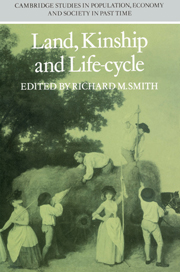Book contents
- Frontmatter
- Contents
- List of contributors
- Preface
- 1 Some issues concerning families and their property in rural England 1250–1800
- 2 Population pressure, inheritance and the land market in a fourteenth-century peasant community
- 3 Families and their land in an area of partible inheritance: Redgrave, Suffolk 1260–1320
- 4 Population changes and the transfer of customary land on a Cambridgeshire manor in the fourteenth century
- 5 Industrial employment and the rural land market 1380– 1520
- 6 Changes in the size of peasant holdings in some west midland villages 1400–1540
- 7 The erosion of the family–land bond in the late fourteenth and fifteenth centuries: a methodological note
- 8 Changes in the link between families and land in the west midlands in the fourteenth and fifteenth centuries
- 9 Kinship in an English village: Terling, Essex 1550–1700
- 10 The myth of the peasantry: family and economy in a northern parish
- 11 Poverty, poor relief and the life-cycle: some evidence from seventeenth-century Norfolk
- 12 The receipt of poor relief and family situation: Aldenham, Hertfordshire 1630–90
- 13 Widows in pre-industrial society: an essay upon their economic functions
- 14 Real property, marriage and children: the evidence from four pre-industrial communities
- 15 The nineteenth-century peasantry of Melbourn, Cambridgeshire
- Consolidated Bibliography
- Index
1 - Some issues concerning families and their property in rural England 1250–1800
Published online by Cambridge University Press: 19 October 2009
- Frontmatter
- Contents
- List of contributors
- Preface
- 1 Some issues concerning families and their property in rural England 1250–1800
- 2 Population pressure, inheritance and the land market in a fourteenth-century peasant community
- 3 Families and their land in an area of partible inheritance: Redgrave, Suffolk 1260–1320
- 4 Population changes and the transfer of customary land on a Cambridgeshire manor in the fourteenth century
- 5 Industrial employment and the rural land market 1380– 1520
- 6 Changes in the size of peasant holdings in some west midland villages 1400–1540
- 7 The erosion of the family–land bond in the late fourteenth and fifteenth centuries: a methodological note
- 8 Changes in the link between families and land in the west midlands in the fourteenth and fifteenth centuries
- 9 Kinship in an English village: Terling, Essex 1550–1700
- 10 The myth of the peasantry: family and economy in a northern parish
- 11 Poverty, poor relief and the life-cycle: some evidence from seventeenth-century Norfolk
- 12 The receipt of poor relief and family situation: Aldenham, Hertfordshire 1630–90
- 13 Widows in pre-industrial society: an essay upon their economic functions
- 14 Real property, marriage and children: the evidence from four pre-industrial communities
- 15 The nineteenth-century peasantry of Melbourn, Cambridgeshire
- Consolidated Bibliography
- Index
Summary
Property has served as a common focus in many discussions of family form. For instance, it has been seen as central in the contrast to be drawn between kinship and residence as two quite different principles of organization. One might therefore distinguish between a jurally defined corporate group linked by rights in property which its members enjoy in common and a collection of kin or indeed non-kin who share a common residence. For Peter Laslett a ‘fraternal joint family’ would exist only when two married brothers co-resided, but for Maurice Freedman such a family would have existed in China whenever two or more brothers were co-parceners in a family estate, regardless of whether these men were married or whether they and their respective wives and children lived in different residences.
To concentrate upon rights in property that are shared by family members as a fundamental variable defining or indeed determining the form taken by the family attaches to the family the specific function of control over property, including its transmission. For it is implicit in so many studies of pre-industrial societies that the most important method of acquiring property is by the process of inheritance. Implicit, too, is the assumption that inheritance normally takes place between close kin and affines. Indeed, as Goody puts it, ‘transmission mortis causa is not only the means by which the reproduction of the social system is carried out …; it is also the way in which interpersonal relationships are structured’.
- Type
- Chapter
- Information
- Land, Kinship and Life-Cycle , pp. 1 - 86Publisher: Cambridge University PressPrint publication year: 1985
- 21
- Cited by

